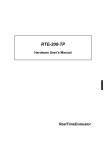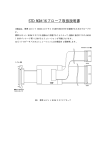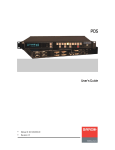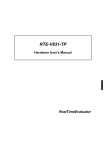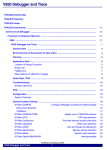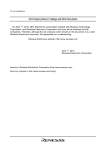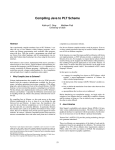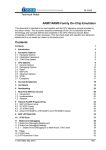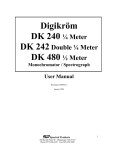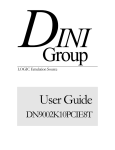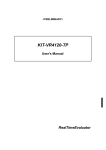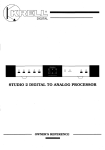Download RTE-2000-TP
Transcript
RTE-2000-TP Hardware User's Manual RealTimeEvaluator RTE-2000-TP Hardware User’s Manual Notice * The copyright associated with this document is proprietary to Midas Lab. Co., Ltd. * This document is protected under applicable copyright laws, and may not be copied, redistributed or modified in whole or in part, in any way without explicit prior written permission from Midas Lab. Co., Ltd. * While this product was manufactured with all possible care, Midas Lab. Co., Ltd. and its distributor assume no responsibility whatsoever for any result of using the product. * The contents and specifications described in this document are subject to change without notice. Trademarks * MS-Windows, Windows, MS and MS-DOS are the trademarks of Microsoft Corporation, U.S.A. * The names of the programs, systems, CPUs, and other products that appear in this document are usually trademarks of the manufacturer of the corresponding product. 1 RTE-2000-TP Hardware User’s Manual REVISION HISTORY Rev.1.00 2000-3-6 Initial Revision Rev.1.01 2001-12-27 Changing as follows: *Changing specification method of enabling write to E.MEM *Changing 8 -bit ROM cable Rev.1.02 2002-2-8 Improving specification of external bus trace board Rev.1.10 2002-7-5 The electric conditions of the following cables are corrected with change. * RTE-NEC/MICTOR38-2K * RTE-ARM/MICTOR38-2K * CBL-ROM16-2K 2 RTE-2000-TP Hardware User’s Manual CONTENTS 1. OVERVIEW ................................................................................................................................................................5 2. MAIN FEATURES ......................................................................................................................................................6 3. HARDWARE SPECIFICATIONS ..............................................................................................................................7 JTAG-N-Wire board modules ...............................................................................................................................7 EMEM board modules............................................................................................................................................8 External bus trace board modules ......................................................................................................................8 4. SYSTEM CONFIGURATION.....................................................................................................................................9 5. COMPONENT NAMES AND FUNCTIONS............................................................................................................10 6. SETTING OF SW1 AND SW2................................................................................................................................12 7. EXT CONNECTOR ..................................................................................................................................................13 8. INSTALLATION PROCEDURE ..............................................................................................................................14 9. CONNECTION TO THE USER SYSTEM ...............................................................................................................15 Connecting JTAG-IF cable...................................................................................................................................15 Connecting ROM cable........................................................................................................................................16 10. POWERING ON AND OFF....................................................................................................................................17 Powering on ...........................................................................................................................................................17 Powering off ...........................................................................................................................................................17 11. JTAG-IF CABLE: RTE-NEC/MICTOR32-2K......................................................................................................18 Conventional type (KEL type)..............................................................................................................................18 <Pin arrangement table>.....................................................................................................................................18 <Connectors>........................................................................................................................................................19 <Wiring and wire length>.....................................................................................................................................19 <Layout of the connectors on the board>.........................................................................................................19 High-speed type (MICTOR type).........................................................................................................................20 <Pin arrangement table>.....................................................................................................................................20 <Connector> ..........................................................................................................................................................21 <Layout of the connector on the board> ...........................................................................................................21 Electrical condition................................................................................................................................................22 JTAG signal timing................................................................................................................................................23 TRACE signal timing ............................................................................................................................................24 12. JTAG-IF CABLE: RTE-ARM/MICTOR38-2K.....................................................................................................25 <Pin arrangement table>.....................................................................................................................................25 <Connector> ..........................................................................................................................................................26 <Board layout>.......................................................................................................................................................26 Electrical condition................................................................................................................................................26 13. STANDARD ROM CABLE: CBL-ROM16-2K....................................................................................................27 Type of signal line .................................................................................................................................................27 Pin arrangement table .........................................................................................................................................27 Connectors.............................................................................................................................................................28 Layout of the connectors (on the board)...........................................................................................................28 3 RTE-2000-TP Hardware User’s Manual Reference of the schematic ................................................................................................................................29 JINH1-JP.................................................................................................................................................................29 Electrical condition................................................................................................................................................30 READ cycle timing.................................................................................................................................................31 WRITE cycle timing...............................................................................................................................................32 14. DIP32-ROM ADAPTER (ADP-STD16-DIP32) ..................................................................................................33 15. DIP40/42-ROM ADAPTER ..................................................................................................................................34 DIP40-ROM adapter: ADP-STD16-DIP40........................................................................................................34 DIP42-ROM adapter: ADP-STD16-DIP42........................................................................................................34 APPENDIX-A MOUNTING BOARD MODULE..........................................................................................................35 APPENDIX-B MOUNTING MEM MODULE...............................................................................................................36 APPENDIX-C APPEARANCE OF CABLE.................................................................................................................38 RTE-NEC/MICTOR38-2K.....................................................................................................................................38 RTE-ARM/MICTOR38-2K.....................................................................................................................................38 Standard ROM cable (RTE-STD16-2K) ............................................................................................................39 DIP-40/42-ROM adapter (ADP-STD16-DIP32/40/42).....................................................................................39 APPENDIX-D PRODUCT LIST (AS OF JANUARY 2002) ......................................................................................40 4 RTE-2000-TP Hardware User’s Manual 1. OVERVIEW RTE-2000-TP is a general-purpose in-circuit emulator that is connected to JTAG. Because it can debug a real processor on-board, this in-circuit emulator supplies highly stable and transparent emulation functions. Its hardware consists of a main enclosure to which up to six boards can be mounted and boards that are modularized in function units. These boards can be used in any combination. Each board consists of re-programmable devices so that it supports future function expansion and eliminates differences between different processors. KIT (KIT-xxxx-TP) is a package of information on the above hardware and control software and is available for each model of processor. This product consists of one of several types of main enclosures of different configurations and optional products. First check the contents of the carton box by referring to the product list attached, to see if any component is missing. The configuration of this product is as follows: RTE-2000-TP-A-X: Items 1 to 5 are included. RTE-2000-TP-B-X: Items 1 to 8 are included. RTE-2000-TP-C-X: Two each of items 1 to 5 and 6 to 8 are included. 1. RTE-2000-TP 1 2. User's manual (This d ocument) 1 3. JTAG-IF cable 1 4. Power supply (RTE-PS04: +5 V, 4.5 A) 1 5. KIT-XXXX-TP This package depends on the target processor, and includes the following. • RTE for Win32 Setup CD-ROM • User's manual • License sheet 6. Emulation memory board 1 (2) 7. Standard ROM cable 1 (2) 8. DIP40, DIP42 adapter 1 each (2 each) The following are required to use RTE-2000-TP, but they are not supplied with the product. Please purchase them separately. 9. Host interface <One of the following is required.> • PC card interface kit • DOS/V DeskTop PC ISA-bus interface kit • DOS/V DeskTop PC PCI-bus interface kit 10. Debugger <Either is required.> • GHS Multi • PARTNER/Win The following options are available upon request. 11. Emulation memory module (additional module having only memory: 8M-byte units) 12. Emulation memory board (8-/16-bit bus units) 13. External bus trace board (customized product) 14. Others 5 RTE-2000-TP Hardware User’s Manual 2. MAIN FEATURES High-level language debuggers Both Multi and PARTNER are high-performance, high-level language debuggers that enable program execution, break point setting, variable inspection, and other operations to be performed at the source level. Easy connection RTE-2000-TP provides debugging capabilities equivalent to those of conventional in-circuit emulators, with the user system connected to the designated connector and the processor mounted on the board. Highly transparent emulation function By controlling the debugging control circuit (DCU) incorporated into the CPU from the outside, RTE-2000-TP provides highly transparent emulation, eliminating the problems associated with electrical interfaces. ROM emulation function ROM of up to 128M bytes and with a 64-bit bus can be emulated. Available are DIP ROMs with 32 to 42 pins and cables and adapters supporting the expansion STD-16BIT-ROM connector (32M bytes max.) to emulate ROM mounted on a board. The access time is as short as 35 ns or less. Real-time trace function RTE-2000-TP enables real-time trace, which is useful for debugging built-in systems. This function is to trace and display program execution in the cache by using a technique to load the trace information that satisfies the specifications of N -Wire-Trace. In addition, the trace function of the external bus can also be added by option (customization). High degree of freedom of product configuration and expandability Configuration that meets your needs can be made by using function module units. In addition, units can be added later with ease. Each unit supports future function expansion by downloading hardware information on starting. 6 RTE-2000-TP Hardware User’s Manual 3. HARDWARE SPECIFICATIONS JTAG-N-Wire board modules Target CPU *1 V831/2 NB85E/NU85E VR5432, VR5500 VR4122, VR4131, VR4181A MIPS32/4Kc ARM946E-S, …more Emulation functions CPU operating frequency *2 Depends on the target processor Interface Supports JTAG/EJTAG/N-Wire JTAG clk 100 kHz-50 MHz (Depends on the target processor) Operation voltage Electrical condition 1.8-5 V LV-TTL Break functions Hardware break points (execution addresses) Software break points Breaks that can be set using access events Depends on the target processor 100 Depends on the target processor Step breaks Supported Manual breaks Supported External breaks Depends on the target processor Trace functions Trace data bus width 4-24 bits Trace memory capacity 256k words Trace clock frequency 100-133 MHz (Depends on the target processor) Trace delay cycle Time tag (time measurement) 0-3FFFF 100 ns-30 h Trigger that can be set using an execution address Depends on the target processor Trigger setting by data access Depends on the target processor Trigger setting by external signal load Supported Start/stop by execution address Depends on the target processor Data trace conditions Depends on the target processor Disassembled trace data display Pin mask functions Supported Depends on the target processor Remarks: *1: New products will be added in the future. *2: The DC characteristics of the JTAG-IF cable may not electrically match if the operating voltage is 2.3 V or less. 7 RTE-2000-TP Hardware User’s Manual EMEM board modules ROM emulation functions *1 Memory capacity 8M-32M bytes Address access time *2 Max. 35 ns (burst cycle: 30 ns) Operation voltage 1.8-5 V Electrical condition LV-TTL, 5-V tolerant Unit of map function in block (USER/EMEM) 64k words Used as RAM Capacity of ROMs that can be emulated (bits) Supported *3 DIP-32pin-ROM (8-bit bus) 1M, 2M, 4M, 8M (27C010/020/040/080) *3 DIP-40pin-ROM (16-bit bus) 1M, 2M, 4M (27C1028/2048/4096) *3 DIP-42pin-ROM (16-bit bus) 8M, 16M (27C8000/16000) STD-16BIT-ROM (16-bit bus) 1M, 2M, 4M, 8M, 16M, 32M, 64M, 128M, 256M (max. 32M bytes) Bus width specification (bits) 8/16/32/64 Remarks: *1: Up to four boards can be mounted in this module w hose maximum capacity is 128M bytes. Two boards are necessary for the 32-bit width, and four boards are necessary for the 64-bit width. One board is necessary for one ROM with an 8-bit bus width. *2: The DC characteristics of the ROM cable may not electrically match if the operating voltage is 2.3 V or less. *3: An adapter is available for the DIP type socket. Use the cable for RTE-2000-TP (CBL-xxxx-2K) as the ROM cable. The operation is not guaranteed if the cable for the existing model is used. External bus trace board modules External bus trace Total number of channels 80 ch (max.) *3 ADDR 32 (64) *3 Data 32 (64) etc (number of CLK sources) 16 (8) *4 Sampling cycle frequency (max.) 100-133 MHz Remarks: In principle, the user IF is for a specific user only and must be customizable. *3: ( ) indicates the number of channels when addresses and data are separately loaded. *4: The upper limit of the sampling frequency depends on the user IF board. 8 RTE-2000-TP Hardware User’s Manual 4. SYSTEM CONFIGURATION The following figure shows the main configuration of a system in which RTE-2000-TP is used. AC adapter (power) GHS Multi PC-AT compatibles PC-AT interface card (ISA, PCI) PARTNER/Win RTE-2000-TP Host system interface cable (supplied with the interface card) KIT-xxxx-TP PC card interface JTAG-IF cable (for user system connection) Note PC with a PC card slot ROM cable (for user system connection) GHS Multi, PARTNER/Win: High-level language debuggers KIT-xxxx-TP: Control software for each processor and hardware information PC: PC capable of running Windows PC-AT interface card: Card supporting the PC-AT ISA bus or PCI bus PC card interface: Type II card (version 2.1 of the PCMCIA specifications/ version 4.2 of the JEIDA specification or later) Host system interface cable: Cable for connecting RTE-2000-TP to the host card AC adapter: Dedicated power supply (RTE-PS04) RTE-2000-TP: Main emulation box (including each board module) JTAG-IF cable: Cable for connecting to the user system used for debugging ROM cable: Cable for ROM emulation 9 RTE-2000-TP Hardware User’s Manual 5. COMPONENT NAMES AND FUNCTIONS This chapter shows the appearance of RTE-2000-TP, as well as the names and functions of its components. (The photographs below show the external bus trace board mounted to RTE-2000-TP-C-x.) Slot #6 Slot #5 Slot #4 Slot #3 Slot #2 Slot #1 <Front view> <Rear view> • Slots #1-#6 Slot #1 JTAG/N-Wire-IF board is mounted in this slot (factory-set condition for shipment). Slot #2 This slot is used to mount an option module. Mount an external bus trace board to this slot. Slots #3-#6 These slots are used to mount emulation memory boards. Sequentially mount the boards to these slots, starting from the lowest slot, #3. • JTAG/N-Wire-IF board module (slot #1) POWER (LED) Lights when power is supplied to the in-circuit emulator. USER POWER (LED) Lights when power is supplied to the user system that is connected to the in-circuit emulator via JTAG-IF cable. CPU-IF Connector to connect the JTAG-IF cable EXT Connector to input/output signals from/to an external device • External bus trace board module (slot #2) EXT. BUS TRACE IF Connector to connect the cable for external bus trace. • EMEM board module (slots #3-#6) E.ROM IF Connector to connect the ROM cable 10 RTE-2000-TP Hardware User’s Manual D0-D7 (LED) Lights when power is supplied to the user system connected to the in-circuit emulator via the ROM cable. D8-D15 (LED) Lights when power is supplied to the user system connected to the in-circuit emulator via the ROM cable. These two LEDs light at the same time when a 16-bit cable is connected and when ADP-STD16-DIP32 is used. Mount EMEM board modules upward starting from slot #3. The correspondence between the numbers of the ROMx commands and modules is as follows: ROM1 command … EMEM board module mounted into slot #3 ROM2 command … EMEM board module mounted into slot #4 ROM3 command … EMEM board module mounted into slot #5 ROM4 command … EMEM board module mounted into slot #6 • Power jack This is a connector for the power supply. Power is supplied by inserting the supplied power supply plug into this jack. Do not connect any device other than the supplied AC adapter (RTE-PS04: +5 V, 4.5 A) to the power jack. • PC (host) connector (HOST) This connector is used for connecting RTE-2000-TP to the PC (host system). The host system interface cable is connected to this connector. • Switch for setting mode SW1, SW2 These switches are used to set modes of the ICE and emulation function. By referring to the manual of KIT-xxxx-TP, set these switches to "OFF" unless otherwise specified. 11 RTE-2000-TP Hardware User’s Manual 6. SETTING OF SW1 AND SW2 Assignment of SW1 and SW2 common to each KIT is shown below. At present, no special function is assigned. Refer to the manual of KIT. SW1 Symbol Function 1 Reserved OFF 2 Reserved OFF 3 Reserved OFF 4 Reserved OFF 5 Reserved OFF 6 Reserved OFF 7 Reserved OFF 8 Reserved OFF SW2 Symbol 1 Reserved OFF 2 Reserved OFF 3 Reserved OFF 4 Reserved OFF 5 Reserved OFF 6 Reserved OFF 7 Reserved OFF 8 Reserved OFF Function Default value Default value Remark: SW1 and SW2 are on the rear panel of the in-circuit emulator. 12 RTE-2000-TP Hardware User’s Manual 7. EXT CONNECTOR The specifications of the EXT connector are shown below. Pin No. (top) Signal name I/O Description A1 RSV-IN0 Input Depends on KIT (pulled up with 1 kΩ) A2 RSV-IN1 Input Depends on KIT (pulled up with 1 kΩ) A3 RSV-OUT Output Depends on KIT (pulled up with 1 kΩ) A4 RESETOUT- Output Reset output. Outputs a low pulse of about 50 ms in response to the RESET command (open-collector output, pulled up with 1 kΩ). A5 GND -- Pin No. (bottom) Signal name I/O B1 EXI0 Input External input signal #0 (pulled up with 1 kΩ), edge-detectable B2 EXI1 Input External input signal #1 (pulled up with 1 kΩ) B3 EXI2 Input External input signal #2 (pulled up with 1 kΩ) B4 EXI3 Input External input signal #3 (pulled up with 1 kΩ) B5 TRG- Output Signal ground Description Trigger output. Goes low when a trace trigger is detected (open-collector output, pulled up with 1 kΩ). Supplement: 1. Input of EXI0 to EXI3 is LV-TTL level. 2. EXI0 can be detected at the edge as a trace trigger. 3. EXI0 to EXI3 are loaded to memory as trigger information. 4. The signals are pulled up to the same voltage as -VCCIO of JTAG-IF. Pin arrangement: 5 4 3 2 1 String A 5 4 3 2 1 String B JEXT pin arrangement Applicable connector: 10-pin connector: OMRON XG4M-1031 (or equivalent) 1-pin jumper cable: ITT Pomona Electronics 4741-12-0 (or equivalent) 13 RTE-2000-TP Hardware User’s Manual 8. INSTALLATION PROCEDURE This chapter describes the procedure for installing RTE-2000-TP. 1. Mount the interface card. → For information, refer to the manual provided with the interface card. 2. Install RTE for WIN32. → For information, refer to the manual provided with RTE for WIN32. At this point, do not start ChkRTE2.EXE. 3. Installing RTE-2000-TP → Usually, the option module is mounted as a factory-set condition for shipment. If an additional module is necessary, mount it by referring to Appendix A. 4. Connect RTE-2000-TP. Connect RTE-2000-TP to the host interface cable using the host system interface cable. Make the AC adapter ready for connection. 5. Connect RTE-2000-TP to the user system. → For details, see Chapter 9. 6. Turn on the power. → For details, see Chapter 10. 7. Set RTE for WIN32. Start ChkRTE2.EXE and set the necessary parameters. → For details, refer to the manual provided with RTE for WIN32 or each KIT-xxxx-TP manual. 8. Run the debugger. → Refer to the manual provided with the debugger. The following figure shows an example of how the devices are connected. PC JTAG connector AC adapter ROM socket or connector RTE-2000-TP CPU Vxxx User system User system connection cable (JTAG-IF and ROM cable) 14 RTE-2000-TP Hardware User’s Manual 9. CONNECTION TO THE USER SYSTEM The procedure for connecting RTE-2000-TP to the user sys tem is described below. Connecting JTAG-IF cable Connect the in-circuit emulator to the user system with the JTAG-IF cable. • Connect the cable to CPU-IF of the JTAG/N-Wire board module of RTE-2000-TP. • Connect the cable to the user system as follows: The end of RTE-NEC/MICTOR38-2K is shown below. The attached cable is used to connect a user system using the connector of KEL. Connect the cable to the connector at the upper part of the end. When the MICTOR connector is used, directly connect the end to the connector of the user system. KEL-26-pin connector RTE-2000-TP Pin 1 (front side) MICTOR-38-pin connector User system Pin 1 (front side) User system End of RTE-NEC/MICTOR38-2K The end of RTE-ARM/MICTOR38-2K is shown below. Directly connect the end to the connector of the user system. RTE-2000-TP MICTOR-38-pin connector Pin 1 (front side) User system End of RTE-ARM/MICTOR38-2K 15 RTE-2000-TP Hardware User’s Manual Connecting ROM cable Connect the in-circuit emulator and the user system with the ROM cable. (Use the adapter as necessary.) • Connect the cable to ROM-IF of the EMEM board module of RTE-2000-TP. • Connect the cable to the user system as follows: <CBL-STD16-2K (same when DIP40 or DIP42 adapter is used)> The cable is a 16-bit ROM cable. As many cables as the number of EMEM board modules can be used. If the system uses two or more cables to configure a bus width of 32 bits or more, connect the cables as follows: 32-bit bus D0-D15: Connect to EMEM board in slot #3. D16-D31: Connect to EMEM board in slot #4. Or, D0-D15: Connect to EMEM board in slot #5. D16-D31: Connect to EMEM board in slot #6. 64-bit bus D0-D15: Connect to EMEM board in slot #3. D16-D31: Connect to EMEM board in slot #4. D32-D47: Connect to EMEM board in slot #5. D48-D63: Connect to EMEM board in slot #6. <ADP-STD-DIP32> Attach the adapter for 8 -bit, DIP-32-pin ROM to an end of CBL-STD16-2K. As many adapters as the number of EMEM board modules can be used. If the system uses two or more cables to configure a bus width of 16 bits or more, connect the adapter as follows: 16-bit bus D0-D7: Connect to EMEM board in slot #3. D8-D15: Connect to EMEM board in slot #4. Or, D0-D7: Connect to EMEM board in slot #5. D8-D15: Connect to EMEM board in slot #6. 32-bit bus D0-D7: Connect to EMEM board in slot #3. D8-D16: Connect to EMEM board in slot #4. D16-D23: Connect to EMEM board in slot #5. D24-D31: Connect to EMEM board in slot #6. Two types of pin assignments are used for a 32-pin ROM of 1M bit or more. Set the jumper on the adapter board in accordance with the ROM to be used. (See Chapter 14, "DIP32-ROM Adapter (ADP-STD16-DIP32)".) 16 RTE-2000-TP Hardware User’s Manual 10. POWERING ON AND OFF The procedures for powering the system on and off are described below. Complete all the steps in the installation procedure (such as cable connection) before powering the system on. Powering on 1. Turn on the power to the host system. 2. Turn on the power to RTE-2000-TP. (Connect the dedicated AC adapter to the power jack of RTE-2000-TP.) 3. Turn on the power to the user system. 4. Start the debugger. Powering off 1. Quit the debugger. 2. Turn off the power to the user system. 3. Turn off the power to RTE-2000-TP. (Disconnect the AC adapter from RTE-2000-TP.) 4. Turn off the power to the host system. Do not turn on the power to the user system before powering on RTE-2000-TP. Doing so may cause a malfunction. 17 RTE-2000-TP Hardware User’s Manual 11. JTAG-IF CABLE: RTE-NEC/MICTOR32-2K RTE-NEC/MICTOR38-2K is a JTAG-IF cable that is used to emulate NEC's CPU. The common specifications of this cable are shown below. Some signals are defined for an individual processor. When using the connectors, therefore, be sure to refer to the documents of the kit. Conventional type (KEL type) The specifications of the interface using the conventional KEL type connector are shown below. Use of a high-speed type connector is recommended if the specifications of a high-speed type are shown in KIT-xxxx-TP. <Pin arrangement table> Pin number Connected signal name Input/output (user side) Standard treatment (user side) A1 TRCCLK Output 22-33 Ω series resistor (recommended) A2 TRCDATA0 Output 22-33 Ω series resistor (recommended) A3 TRCDATA1 Output 22-33 Ω series resistor (recommended) A4 TRCDATA2 Output 22-33 Ω series resistor (recommended) A5 TRCDATA3 Output 22-33 Ω series resistor (recommended) A6 TRCEND Output 22-33 Ω series resistor (recommended) A7 DDI Input 4.7-10 kΩ pull-up or pull-down A8 DCK Input 4.7-10 kΩ pull-up or pull-down A9 DMS Input 4.7-10 kΩ pull-up or pull-down A10 DDO Output A11 DRST- Input 4.7-50 kΩ pull-down A12 Reserved ------ (Depends on KIT) A13 Reserved ------ (Depends on KIT) Pin number Connected signal name Input/output (user side) B1-B10 GND ------ Connection to GND B11 Reserved ------ (Depends on KIT) B12 Reserved ------ (Depends on KIT) B13 VCCIO ------ Connect to the power supply for the CPU external bus. 22-33 Ω series resistor (recommended) Treatment (user side) Remark: I/O (user side) is the signal flow viewed at the user board side. 18 RTE-2000-TP Hardware User’s Manual <Connectors> Manufacturer: KEL Models: 8830E-026-170S (straight) 8830E-026-170L (right angle) 8831E-026-170L (right angle, fixing hardware attached) <Wiring and wire length> 1. Keep the wire from the buffer or CPU to the connector as short as possible. 100 mm or shorter is recommended. 2. Output signals from the CPU are recommended to be connected to connectors, via high-speed CMOS buffers of which power supply is the same as for CPU I/O buffers. <Layout of the connectors on the board> The figure below shows the physical layout of the connectors on the board. B13 A13 B12 A12 Polarity indication B2 A2 B1 A1 Board end [Top view] Caution: When actually arranging the pins, design them according to the connector dimensional information. 19 RTE-2000-TP Hardware User’s Manual High-speed type (MICTOR type) The specifications of the interface using the high-speed type MICTOR connector are shown below. Use of a high-speed type connector is recommended if the specifications of a high-speed type are shown in KIT-xxxx-TP. <Pin arrangement table> Pin number Connected signal name Input/output (user side) Treatment (user side) 1 GND --- 3 (A8) DCK Input Connection to GND 4.7-10 kΩ pull-up or pull-down 5 (A9) DMS Input 4.7-10 kΩ pull-up or pull-down 7 (A7) DDI Input 4.7-10 kΩ pull-up or pull-down 9 (A10) DDO Output 11 Reserved 1 Open 13 Reserved 2 Open 22-33 Ω series resistor (recommended) 15 Reserved 3 17 (A1) TRCCLK Output Open 22-33 Ω series resistor (recommended) 19 (A6) TRCEND Output 22-33 Ω series resistor (recommended) 21 (A2) TRCDATA0 Output 22-33 Ω series resistor (recommended) 23 (A3) TRCDATA1 Output 22-33 Ω series resistor (recommended) 25 (A4) TRCDATA2 Output 22-33 Ω series resistor (recommended) 27 (A5) TRCDATA3 Output 22-33 Ω series resistor (recommended) 29 TRCDATA4 Output (Depends on KIT) 31 TRCDATA5 Output (Depends on KIT) 33 TRCDATA6 Output (Depends on KIT) 35 TRCDATA7 Output (Depends on KIT) 37 GND --- Pin number Connected signal name Input/output (user side) 2 GND --- Connection to GND 4 (B13) VCCIO --- Connect this signal to I/O power supply of CPU (for monitoring power). 6 (A11) DRST- Input 4.7-50 kΩ pull-down 8 (A12) PORT1_OUT Input (Depends on KIT) 10 (A13) PORT2_OUT Input (Depends on KIT) Connection to GND Treatment (user side) 12 PORT3_OUT Input (Depends on KIT) 14 (B11) PORT1_IN Output (Depends on KIT) 16 (B12) PORT2_IN Output (Depends on KIT) 18 PORT3_IN Output (Depends on KIT) 20 TRCCE Input (Depends on KIT) 22 TRCDATA8 Output (Depends on KIT) 24 TRCDATA9 Output (Depends on KIT) 26 TRCDATA10 Output (Depends on KIT) 28 TRCDATA11 Output (Depends on KIT) 30 TRCDATA12 Output (Depends on KIT) 32 TRCDATA13 Output (Depends on KIT) 34 TRCDATA14 Output (Depends on KIT) 20 RTE-2000-TP Hardware User’s Manual 36 TRCDATA15 Output 38 GND --- (Depends on KIT) Connection to GND Remark: ( ) indicates the equivalent pin of the KEL type connector. I/O (user side) is the signal flow viewed at the user board side. <Connector> Manufacturer: AMP Model: 2-767004-2 (receptacle) <Layout of the connector on the board> The figure below shows the physical layout of the connector on the board. • Lay out the connector so that the odd-numbered pins are at the device side. • Keep the length of the connector to 50 mm or less. • Shield the clock signal. • The even-numbered pins of the connector are connected to the board at the end of the cable. Do not place components measuring 10 mm or more in height below this cable. CPU MICTOR connector 1 37 2 38 Caution: When actually arranging the pins, design them according to the connector dimensional information. 21 RTE-2000-TP Hardware User’s Manual Electrical condition Absolute Maximum Ratings Parameter Symbol Rating Unit Supply voltage VDD -0.5~+5.5 V Output voltage VO -0.5~VDD+0.3V V Input voltage VI -0.5~+5.5 V TA +5~+35 °C Operating temperature Note: The VDD is power voltage on target( = VCCIO of JTAG-IF) Capacitance (TA=25°C) Parameter Symbol MIN TYP MAX Input capacitance Output capacitance Unit CI 50 ρF Co 50 ρF DC Characteristics (TA=+5°C~+35°C, 1.8V<VDD<=5.0V) :VDD = VCCIO of JTAG-IF Parameter Input Voltage high Input Voltage low Condition VDD(V) Symbol VIH VIL 1.7 IOH = -100µA Output Voltage high VOH VOL TYP MAX Unit 5.5 0.7 V V VDD-0.2 V IOH = -4mA 1.8 1.2 V IOH = -8mA 2.3 1.75 V IOH = -12mA 3 2.3 V IOL = 100µA Output Voltage low MIN 0.2 V IOL = 4mA 1.65 0.45 V IOL = 8mA 2.3 0.55 V IOL = 12mA 3.0 0.7 V ILIH VI =3.6 3.6 2.5 µA Input leakage current low ILIL VI =0V 3.6 -15 µA Output leakage current high ILOH VO=VDD 3.6 10 µA Output leakage current low ILOL VO=0V 3.6 -10 µA 1.8-1.95 -4 mA Output current high IOH 2.3-2.7 -8 mA 3.0-3.6 -12 mA 1.8-1.95 4 mA 2.3-2.7 8 mA 3.0-3.6 12 mA 5.0 2.5 mA Input leakage current high Output current low VDD current IOL IVDD 22 RTE-2000-TP Hardware User’s Manual JTAG signal timing Timing diagram t1 t2 t3 DCK t4 DMS, DDI Valid t5 DDO t6 Valid t7 DRST AC Characteristics (TA= +5°C ~+35°C, 1.8V<VDD<=5.0V):VDD = VCCIO of JTAG-IF Parameter Symbol Min Max Unit DCK Cycle Width t1 40 DCK Cycle Low Width t2 17 DCK Cycle Low Width t3 17 Tdly:DCK->DDI,DMS t4 Tsu:DDO/DCK ↓ t5 13.5 nS Thold:DDO/DCK ↓ t6 0 nS DRST Low Width t7 1000 nS Remarks nS 23 nS 23 nS 8.5 nS AC input/output waveforms VCC 1.5V TEST POINT 1.5V VSS Load condition ICE C=15pF 23 RTE-2000-TP Hardware User’s Manual TRACE signal timing Timing diagram t1 t2 t3 TRC TL K t4 t5 TRCDATAx Valid TRC END AC Characteristics (TA= +5°C ~+35°C, 1.8V<VDD<=5.0V):VDD = VCCIO of JTAG-IF Parameter Symbol Min TRCCLK Cycle Width t1 7.5 nS TRCCLK Cycle Low Width t2 3 nS TRCCLK Cycle High Width Tsu:TRCDATA,../ t3 t4 3 3/5/7/ nS nS TRCCLK ↑ Max Unit 9 Remarks typical value is 7nS. Adjustment range: -> 3 - 9nS(Option) Thold:TRCDATA,../ t5 0 nS TRCCLK ↑ AC input waveforms VCC 1.5V TEST POINT 1.5V VSS 24 RTE-2000-TP Hardware User’s Manual 12. JTAG-IF CABLE: RTE-ARM/MICTOR38-2K RTE-ARM/MICTOR38-2K is a JTAG-IF cable that is used to emulate ARM. The common specifications are shown below. Some signals are defined for an individual processor. When using the connectors, therefore, be sure to refer to the documents of the kit. <Pin arrangement table> Pin number Connected signal name Input/output (user side) Treatment (user side) 1 NC. --- Not used 3 NC. --- Not used 5 Reserved --- Not used 7 DGBRQ Input 4.7-10 kΩ pull-down 4.7-10 kΩ pull-up 9 nSRST Input 11 TDO Output 22-33 Ω series resistor (recommended) 13 RTCLK Output 22-33 Ω series resistor (recommended) 15 TCK Input 4.7-10 kΩ pull-up or pull-down 17 TMS Input 4.7-10 kΩ pull-up or pull-down 19 TDI Input 4.7-10 kΩ pull-up or pull-down 21 nTRST Input 4.7-50 kΩ pull-down 23 TRACEPKT[15] Output 22-33 Ω series resistor (recommended) 25 TRACEPKT[14] Output 22-33 Ω series resistor (recommended) 27 TRACEPKT[13] Output 22-33 Ω series resistor (recommended) 29 TRACEPKT[12] Output 22-33 Ω series resistor (recommended) 31 TRACEPKT[11] Output 22-33 Ω series resistor (recommended) 33 TRACEPKT[10] Output 22-33 Ω series resistor (recommended) 35 TRACEPKT[9] Output 22-33 Ω series resistor (recommended) 37 TRACEPKT[8] Output 22-33 Ω series resistor (recommended) Pin number Connected signal name Input/output (user side) 2 NC. --- Not used Not used Treatment (user side) 4 NC. --- 6 TRACECLK Output 22-33 Ω series resistor (recommended) 8 DBGACK Output 22-33 Ω series resistor (recommended) 10 EXTTRIG Input Connecting this signal to unused interrupt input is recommended (option). 12 VTRef Output Connect this signal to I/O power supply of CPU (for monitoring power). 14 Vsuuply Output Connect this signal to I/O power supply of CPU (not used by ICE). 16 TRACEPKT[7] Output 22-33 Ω series resistor (recommended) 18 TRACEPKT[6] Output 22-33 Ω series resistor (recommended) 20 TRACEPKT[5] Output 22-33 Ω series resistor (recommended) 22 TRACEPKT[4] Output 22-33 Ω series resistor (recommended) 24 TRACEPKT[3] Output 22-33 Ω series resistor (recommended) 26 TRACEPKT[2] Output 22-33 Ω series resistor (recommended) 28 TRACEPKT[1] Output 22-33 Ω series resistor (recommended) 25 RTE-2000-TP Hardware User’s Manual 30 TRACEPKT[0] Output 22-33 Ω series resistor (recommended) 32 TRACESYNC Output 22-33 Ω series resistor (recommended) 34 PIPSTAT[2] Output 22-33 Ω series resistor (recommended) 36 PIPSTAT[1] Output 22-33 Ω series resistor (recommended) 38 PIPSTAT[0] Output 22-33 Ω series resistor (recommended) <Connector> Manufacturer: AMP Model: 2-767004-2 (receptacle) <Board layout> The figure below shows the physical layout of the connector on the board. • Lay out the connector so that the odd-numbered pins are at the device side. • Keep the wiring length to the connector as short as possible. The recommended length is 50 mm or less. • Shield the clock signal. • The even-numbered pins of the connector are connected to the board at the end of the cable. Do not place components measuring 10 mm or more in height below this cable. CPU MICTOR connector 1 37 2 38 Caution: When actually arranging the pins, design them according to the connector dimensional information. Electrical condition It applies to RTE-NEC/MICTOR38-2K correspondingly. 26 RTE-2000-TP Hardware User’s Manual 13. STANDARD ROM CABLE: CBL-ROM16-2K This cable supports the STD-16BIT-ROM connector recommended by NEC. Usually, ROM can be emulated while mounted on a board by preparing this connector on the board. Adapters to be attached to the ends of this cable are available for ROM of DIP-40 and DIP-42. Type of signal line Signal IN/OUT Name Description A0-A23 IN ADDRESS BUS Connect address signals equivalent to those of ROM to these signals. • Connect the higher address signals that are not used to GND. • Connect the A1 signal of the CPU to A0 of the 16-bit bus. • Connect the A2 signal of the CPU to A0 of the 32-bit bus. D0-D15 OUT DATA BUS Connect data signals equivalent to those of ROM to these signals. CE- IN CHIP ENABLE OE- IN OUTPUT ENABLE If CE- is LOW and this signal is LOW, ROM emulator will output the data bus signals. WRLWRH- IN Write low -byte Write High-byte Connect a low -active write signal to this signal to write data to the emulation memory. Connecting a write signal is not essential, however. When this signal is not used, fix it to the high level. PSENSE IN POWER SENSE Connect this signal to VDD on the ROM power supply (for monitoring power). INH- OUT INHBIT- GND ----- GND ROM emulator is selected at LOW level. Use this signal to disable ROM on the board. The following two signals can be selected by selection of JINH1 . Side 1: Select GND. Always drive this signal low. Side 3: Select EMEMEN-. This signal outputs a low level only when the emulation memory is selected. Connect to GND on a board. Pin arrangement table A side A1 A2 A3 A4 A5 A6 A7 A8 A9 A10 A11 A12 A13 A14 A15 A16 A17 A18 A19 A20 A21 Signal GND A1 A3 A5 A7 A9 A11 A13 A15 A17 A19 A21 (WRH-) (WRL-) CEOED0 D2 D4 D6 D8 B side B1 B2 B3 B4 B5 B6 B7 B8 B9 B10 B11 B12 B13 B14 B15 B16 B17 B18 B19 B20 B21 Signal A0 A2 A4 A6 A8 A10 A12 A14 A16 A18 A20 A22 INH- (GND/EMEMEN-) A23 GND PSENSE (VDD IN) D1 D3 D5 D7 D9 27 RTE-2000-TP Hardware User’s Manual A22 A23 A24 A25 D10 D12 D14 GND B22 B23 B24 B25 D11 D13 D15 GND Connectors Manufacturer: KEL Models: 8931E-050-178S (straight) 8931E-050-178L (right angle) 8930E-050-178MS (SMT straight) Layout of the connectors (on the board) A25 B25 1-pin mark A1 B1 Edge of board 28 RTE-2000-TP Hardware User’s Manual Reference of the schematic The following shows the circuit of the connector provided for the 16-bit ROM, for your reference. A[1..23] D[0..15] CN1 U1 A1 A2 A3 A4 A5 A6 A7 A8 A9 A10 A11 A12 A13 A14 A15 A16 A17 A18 A19 A20 10 9 8 7 6 5 4 3 41 40 39 38 37 36 35 34 33 2 1 42 VCC 32 11 13 A0 A1 A2 A3 A4 A5 A6 A7 A8 A9 A10 A11 A12 A13 A14 A15 A16 A17 A18 A19 DO0 DO1 DO2 DO3 DO4 DO5 DO6 DO7 DO8 DO9 DO10 DO11 DO12 DO13 DO14 DO15/A-1 14 16 18 20 23 25 27 29 15 17 19 21 24 26 28 30 D0 D1 D2 D3 D4 D5 D6 D7 D8 D9 D10 D11 D12 D13 D14 D15 A2 A4 A6 A8 A10 A12 A14 A16 A18 A20 A22 WRHWRLD0 D2 D4 D6 D8 D10 D12 D14 VCC VCC BYTE-/VPP CEOE- VSS1 VSS2 27C16000 A1 A2 A3 A4 A5 A6 A7 A8 A9 A10 A11 A12 A13 A14 A15 A16 A17 A18 A19 A20 A21 A22 A23 A24 A25 22 12 31 GND GND A1 A3 A5 A7 A9 A11 A13 A15 A17 A19 A21 WRHWRLCEOED0 D2 D4 D6 D8 D10 D12 D14 GND A0 A2 A4 A6 A8 A10 A12 A14 A16 A18 A20 A22 INHA23 GND PSENSE D1 D3 D5 D7 D9 D11 D13 D15 GND B1 B2 B3 B4 B5 B6 B7 B8 B9 B10 B11 B12 B13 B14 B15 B16 B17 B18 B19 B20 B21 B22 B23 B24 B25 A1 A3 A5 A7 A9 A11 A13 A15 A17 A19 A21 A23 A24 VCC D1 D3 D5 D7 D9 D11 D13 D15 JROMEMLT GND MRD- GND VCC U2A U3A 1 2 1 R1 3 2 10K INV NAND U3B 4 6 ROMCS- 5 NAND JINH1-JP When using ADP-STD16-DIP40 or ADP-STD16-DIP42, be sure to set JP of JINH1 to side 1. If it is set to side 3, malfunctioning may occur. 29 RTE-2000-TP Hardware User’s Manual Electrical condition Absolute Maximum Ratings Parameter Symbol Rating Unit Supply voltage VDD -0.5~+5.5 V Output voltage VO -0.5~VDD+0.3V V Input voltage VI -0.5~+5.5 V TA +5~+35 °C Operating temperature Note: The VDD is power voltage on target( = PSENSE(VDD IN) of ROM-IF) Capacitance (TA=25°C) Parameter Symbol MIN TYP MAX Input capacitance Output capacitance Unit CI 50 ρF Co 50 ρF DC Characteristics (TA=+5°C~+35°C, 1.8V<VDD<=5.0V) :VDD = PSENSE(VDD IN) of ROM-IF Parameter Input Voltage high Input Voltage low Condition VDD(V) Symbol VIH VIL 1.7 IOH = -100µA Output Voltage high VOH VOL TYP MAX Unit 5.5 0.7 V V VDD-0.2 V IOH = -4mA 1.8 1.2 V IOH = -8mA 2.3 1.75 V IOH = -12mA 3 2.3 V IOL = 100µA Output Voltage low MIN 0.2 V IOL = 4mA 1.65 0.45 V IOL = 8mA 2.3 0.55 V IOL = 12mA 3.0 0.7 V ILIH VI =3.6 3.6 2.5 µA Input leakage current low ILIL VI =0V 3.6 -15 µA Output leakage current high ILOH VO=VDD 3.6 10 µA Output leakage current low ILOL VO=0V 3.6 -10 µA 1.8-1.95 -4 mA Output current high IOH 2.3-2.7 -8 mA 3.0-3.6 -12 mA 1.8-1.95 4 mA 2.3-2.7 8 mA 3.0-3.6 12 mA 5.0 2.5 mA Input leakage current high Output current low VDD current IOL IVDD 30 RTE-2000-TP Hardware User’s Manual READ cycle timing ADDR A1 A2 t1 t1 CSt2 t4 OEt3 t3 t4 D1 DATA D2 t6 t5 t6 EMEMEN- AC Characteristics (TA= +5°C ~+35°C, 1.8V<VDD<=5.0V):VDD = PSENSE(VDD IN) of ROM-IF Item Symbol ADDR -> DATA t1 Min. Max. Unit Remarks 30 nS Access time from the address A0..A15 35 nS Access time from the address higher than or equal to A16 CS- -> DATA t2 35 nS Access time from the CS- active CS-/OE- -> DATA t3 19 nS DATA output delay from CS- and OEactive CS-/OE- -> DATA t4 19 nS DATA-Hiz delay from CS- or OEinactive ADDR -> EMEMEN- t5 22 nS Determination time from ADDR to EMEMEN- CS- -> EMEMEN- t6 15 nS Determination time from CS- to EMEMENLoad condition: 15pF AC input/output waveforms VCC 1.5V TEST POINT 1.5V VSS 31 RTE-2000-TP Hardware User’s Manual WRITE cycle timing ADDR t1 t4 CSt2 t5 OEt3 t7 t6 WRxt9 t8 DATA t10 t11 t10 t11 EMEMEN- AC Characteristics (TA= +5°C ~+35°C, 1.8V<VDD<=5.0V):VDD = PSENSE(VDD IN) of ROM-IF Item Symbol Min. Max. Tsu:ADDR/WRx- ↓ t1 10 nS Setup of ADDR vs. WRx- ↓ Tsu:CS-/WRx- ↓ t2 10 nS Setup of CS- vs. WRx- ↓ Tsu:OE-/-WRx- ↓ t3 10 nS Setup of OE- vs. WRx- ↓ Thold:ADDR/WRx- ↑ t4 10 nS Hold of ADDR vs. WRx- ↑ Thold:CS-/WRx- ↑ t5 10 nS WHold of CS- vs. WRx- ↑ Thold:OE-/WRx- ↑ t6 10 nS Hold of OE- vs. WRx- ↑ Twide:WRx- t7 20 nS Active time of WRx- Tsu:DATA/WRx- ↓ t8 18 nS WSetup of DATA vs. WRx- ↓ Thold:DATA/WRx- ↑ t9 8 nS Hold of DATA vs. WRx- ↑ ADDR -> EMEMEN- t10 nS Determination time from ADDR to 22 Unit Remarks EMEMENCS- -> EMEMEN- t11 15 nS CDetermination time from CS- to EMEMENLoad condition: 15pF AC input/output waveforms VCC 1.5V TEST POINT 1.5V VSS 32 RTE-2000-TP Hardware User’s Manual 14. DIP32-ROM ADAPTER (ADP-STD16-DIP32) Attach the adapter for DIP 32-pin ROM to an end of the standard ROM cable. The pin arrangement of the adapter is shown below. The DIP 32-pin ROM probe supports the following two types of pin arrangements. Selection can be made by using jumpers J1 and J2. J1 and J2: Shorted to OE:24Pin side (factory-set condition for shipment) A19 A16 A15 A12 A7 A6 A5 A4 A3 A2 A1 A0 D0 D1 D2 GND 1 2 3 4 5 6 7 8 9 10 11 12 13 14 15 16 32 31 30 29 28 27 26 25 24 23 22 21 20 19 18 17 Vdd A18 A17 A14 A13 A8 A9 A11 OEA10 CED7 D6 D5 D4 D3 32 31 30 29 28 27 26 25 24 23 22 21 20 19 18 17 Vdd A18 A17 A14 A13 A8 A9 A11 A16 A10 CED7 D6 D5 D4 D3 J1 and J2: Shorted to OE:2Pin side A19 OEA15 A12 A7 A6 A5 A4 A3 A2 A1 A0 D0 D1 D2 GND 1 2 3 4 5 6 7 8 9 10 11 12 13 14 15 16 Be sure to set J1 and J2 in the same manner. Shorting to OE:24Pin side OE:24PIN← J1 J2 → OE:2PIN J2 →OE:2PIN Shorting to OE:2Pin side OE:24PIN ← J1 Use RT4WIN32 Ver.5.06 or later of ADP-STD16-DIP32. 33 RTE-2000-TP Hardware User’s Manual 15. DIP40/42-ROM ADAPTER The adapter for DIP 40-pin or DIP 42-pin ROM is attached to an end of the standard ROM cable. DIP40-ROM adapter: ADP-STD16-DIP40 The DIP 40-pin ROM adapter supports the following pin arrangement. (A18) CSD15 D14 D13 D12 D11 D10 D9 D8 GND D7 D6 D5 D4 D3 D2 D1 D0 OE- 1 2 3 4 5 6 7 8 9 10 11 12 13 14 15 16 17 18 19 20 40 39 38 37 36 35 34 33 32 31 30 29 28 27 26 25 24 23 22 21 Vdd A17 A16 A15 A14 A13 A12 A11 A10 A9 GND A8 A7 A6 A5 A4 A3 A2 A1 A0 DIP42-ROM adapter: ADP-STD16-DIP42 The DIP 42-pin ROM adapter supports the following pin arrangement. A18 A17 A7 A6 A5 A4 A3 A2 A1 A0 CEGND OED0 D8 D1 D9 D2 D10 D3 D11 1 2 3 4 5 6 7 8 9 10 11 12 13 14 15 16 17 18 19 20 21 42 41 40 39 38 37 36 35 34 33 32 31 30 29 28 27 26 25 24 23 22 A19 A8 A9 A10 A11 A12 A13 A14 A15 A16 NC. GND D15 D7 D14 D6 D13 D5 D12 D4 Vdd When using ADP-STD16-DIP40 or ADP-STD16-DIP42 with CBL-STD16-2K, be sure to set JP of JINH1 of CBL-STD16-2K to side 1. If it is set to side 3, malfunctioning may occur. 34 RTE-2000-TP Hardware User’s Manual APPENDIX-A MOUNTING BOARD MODULE Mount board modules as follows: <Preparation> Determine the position (slot) to which the board module is to be mounted and remove the plate of the slot by pushing it inward. At this time, do not touch the plate of the slot to which no module is mounted. If the removed plate drops inside the in-circuit emulator, take it out from a gap. The mounting positions of the board modules are determined. Mount the modules to the correct positions by referring to Chapter 5. <Mounting> <1> Remove the pillars at both sides of the in-circuit emulator by moving them to the left and the right, respectively. <2> Insert a board module into a slot as far as it goes, until the connector of the module is securely connected to the connector in the slot. At this time, confirm that the projection for fixing the board is inserted into the hole on the panel of the module. <3> Attach the pillars removed in <1> to the original positions. This completes mounting. <3> <1> <3> <1> <2> 35 RTE-2000-TP Hardware User’s Manual APPENDIX-B MOUNTING MEM MODULE Mount the MEM module as follows: <Removing E.MEM base board> <1> Remove the pillars at both sides of the in-circuit emulator by moving them to the left and the right, respectively. <2> Take out the board module. To do this, insert a coin or similar object in the gap (several mm) between the panel mounted on the board and the in-circuit emulator, and push the board forward. (Remove the board from the left side first when viewed from the front of the in-circuit emulator for smooth removal.) Do not touch a corner of the panel while removing the board module because it is sharp and may hurt you. <Mounting E.MEM module> <3> Up to three MEM modules can be mounted on one E.MEM base board. Mount the boards in the following procedure. If some board is skipped, the memory does not correctly recognize the boards. First board: JERAM2-1 Second board: JERAM2-2 Third board: JERAM2-3 The MEM module must be mounted in the correct direction. Match the ∇ marks on the E.MEM base board and MEM module. 36 RTE-2000-TP Hardware User’s Manual <Mounting E.MEM base board> <4> Insert a board module into a slot as far as it goes, until the connector of the module is securely connected to the connector in the slot. At this time, confirm that the projection for fixing the board is inserted into the hole on the panel of the m odule. <5> Attach the pillars removed in <1> to the original positions. For how to remove and mount the E.MEM base board, see the figure in Appendix A. This completes mounting. E.MEM base board MEM modules <1> <2> <3> 37 RTE-2000-TP Hardware User’s Manual APPENDIX-C APPEARANCE OF CABLE RTE-NEC/MICTOR38-2K 280-300 mm 27 mm 15 mm 26 mm 56 mm 38 mm 12 mm 50-60 mm 14 mm 47 mm 8.5 mm 10 mm 11 mm 41 mm RTE-ARM/MICTOR38-2K 280-300 mm 27 mm 11 mm 28 mm 16 mm 10 mm 11 mm 56 mm 43 mm 38 RTE-2000-TP Hardware User’s Manual Standard ROM cable (RTE-STD16-2K) 280-300 mm 55 mm 69 mm 20 mm 49 mm 36 mm Pin 1 1-pin mark 11 mm 14 mm DIP-40/42-ROM adapter (ADP-STD16-DIP32/40/42) 19 mm Pin 1 DIP-32 = 44.5 mm DIP-40 = 51.0 mm DIP-42 = 53.5 mm Standard ROM cable 25 mm 10 mm 15.24 mm 39 RTE-2000-TP Hardware User’s Manual APPENDIX-D PRODUCT LIST (AS OF JANUARY 2002) <RTE-2000-TP-related> Part number Description RTE-2000-TP-A-x Minimum basic configuration Main enclosure + power supply + JTAG/N-WIRE module + JTAG-IF cable + KIT-XXXX-TP RTE-2000-TP-B-x 16-bit bus standard configuration RTE-2000-TP-A + RTE-EMEM-B8 + CBL-STD16-2K + ADP-STD16-DIP40 + ADP-STD16-DIP42 (1 unit each) RTE-2000-TP-C-x 32-bit bus standard configuration RTE-2000-TP-A + RTE-EMEM-B8 + CBL-STD16-2K (2 sets each) + ADP-STD16-DIP40 + ADP-STD16-DIP42 (2 units each) Suffix -x indicates the type of the JTAG-IF cable. -N: RTE-NEC/MICTOR38-2K, -A: RTE-ARM/MICTOR38-2K <JTAG-IF cable-related> Part number Description RTE-NEC/MICTOR38-2K NEC specification IF cable, both of MICTOR38 and KEL are supported RTE-ARM/MICTOR38-2K ARM specification IF cable, ETM supporting type MICTOR38 is supported <Emulation memory-related> Part number Description RTE-EMEM-B8 Base module of emulation memory (for mounting 8M bytes) … 4 units max. RTE-MM-8M Additional memory module for base module (8M bytes) … 3 units max. CBL-STD16-2K Standard ROM cable for RTE-2000-TP ADP-STD16-DIP32 Adapter for DIP 32-pin (attached to tip of CBL-STD16-2K) ADP-STD16-DIP40 Adapter for DIP 40-pin (attached to tip of CBL-STD16-2K) ADP-STD16-DIP42 Adapter for DIP 42-pin (attached to tip of CBL-STD16-2K) <External bus trace-related> Part number Description RTE-BTRC-A Base module for external bus trace RTE-BTRC-xxxx (custom) Set of RTE-BTRC-A, attachment for xxxx, and other components 40 RTE-2000-TP Hardware User’s Manual <KIT list> Part number Description KIT-V831/2-TP Kit supporting V831/V832 (manual, rte4win32, license) KIT-NB85E-TP Kit supporting Nx85E (manual, rte4win32, license) KIT-VR4120-TP Kit supporting VR4122 (manual, rte4win32, license) KIT-VR4131-TP Kit supporting VR4131 (manual, rte4win32, license) KIT-VR4181A-TP Kit supporting VR4181A (manual, rte4win32, license) KIT-VR5400-TP Kit supporting VR5432 (manual, rte4win32, license) KIT-VR5500-TP Kit supporting VR5500 (manual, rte4win32, license) KIT-MIPS32/4Kc-TP Kit supporting MIPS32/4Kc (manual, rte4win32, license) KIT-ARM946ES-TP Kit supporting ARM946ES (manual, rte4win32, license) <Partner list> Part number Description PT-V831/2-TP Partner supporting KIT-V831/2-TP PT-NB85E-TP Partner supporting KIT-NB85E-TP PT-VR4120-TP Partner supporting KIT-VR4120-TP PT-VR4131-TP Partner supporting KIT-VR4131-TP PT-VR4181A-TP Partner supporting KIT-VR4181A-TP PT-VR5400-TP Partner supporting KIT-VR5400-TP PT-VR5500-TP Partner supporting KIT-VR5500-TP PT-MIPS32/4Kc-TP Partner supporting KIT-MIPS32/4Kc-TP PT-ARM9-TP Partner supporting KIT-ARM946ES-TP Remark: This list includes those still under development. Consult the nearest distributor for availability. 41










































